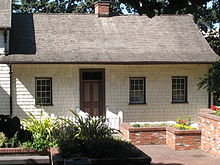Helmcken House
The Helmcken House is the oldest surviving building in Victoria , the capital of the Canadian province of British Columbia . The house, built in 1852, is right next to the Royal British Columbia Museum and now houses part of the museum.
The house is named after Dr. John Sebastian Helmcken , a German-born doctor and politician who played a crucial role in the creation of Canada. He lived in the house, the easternmost part of which is the oldest, from 1852 until his death in 1920.
Helmcken married Cecilia Douglas (1834-1865) on December 27, 1852, the eldest daughter of Governor James Douglas , with whom he had four sons and three daughters. Cecilia Helmcken died in 1865, so that Helmcken stayed behind with the four surviving children. She was buried in the garden.
The house was built on a plot of land near the Inner Harbor, where the Indians originally lived. These local Indians, the Songhees , helped him build the house, for example by cutting the roof shingles or building the garden and well or removing the tree stumps. In the garden were Camassia quamash , an edible plant that the Songhees cultivated on a large scale. Helmcken's mother-in-law, Amelia Morgan, had taught her daughter French and Cree , her mother tongue, in addition to English . Although Helmcken did not learn the Songhee language, his eldest daughter was named after her mother-in-law.
In 1871, after the province was annexed to Canada, Helmcken withdrew from politics and devoted himself to medicine, without turning down lucrative occupations such as the post of director of the Canadian Pacific Railway , the Canadian transcontinental railroad. In 1885 he became the founding president of the British Columbia Medical Association , and practiced in the provincial prison from 1851 to 1910.

In the house, next to Helmcken and his four children, lived a Chinese servant named Ah Tan (born around 1855), at times probably a second servant, and each a housekeeper, initially “Mrs. Wilde ", later" Mrs. Foreman ".
Therefore Helmcken enlarged the house in 1882 by adding another extension. While the oldest part was made from logs in the form of a log cabin, boards were now preferred as the outer skin.
After Helmcken's death, his daughter Edith (Dolly) Helmcken (1863-1939) took over the house, which she lived in until her death in 1939. She actually wanted to have all of her father's records destroyed after her death, but let the provincial librarian and archivist W. Kaye Lamb change her mind. So she bequeathed the entire collection and the house to the archives of British Columbia .
Inside and out, the house has largely been preserved in its state from 1920, especially since Dolly Helmcken left everything as it was at the time of her father's death. Even his suits were still in place. In addition, there are furnishings, such as some of the pictures, but above all all the utensils necessary for a doctor.
Right across from Helmcken House is St. Anne's School, a school run by nuns. Helmcken's daughters attended this school.
Web links
Remarks
- ^ Helmcken House and St. Ann's Schoolhouse. Royal British Columbia Museum, accessed November 15, 2018 .
- ↑ They appear in Martha Douglas' diary (1866–1869).
Coordinates: 48 ° 25 '12 " N , 123 ° 21' 59.4" W.

